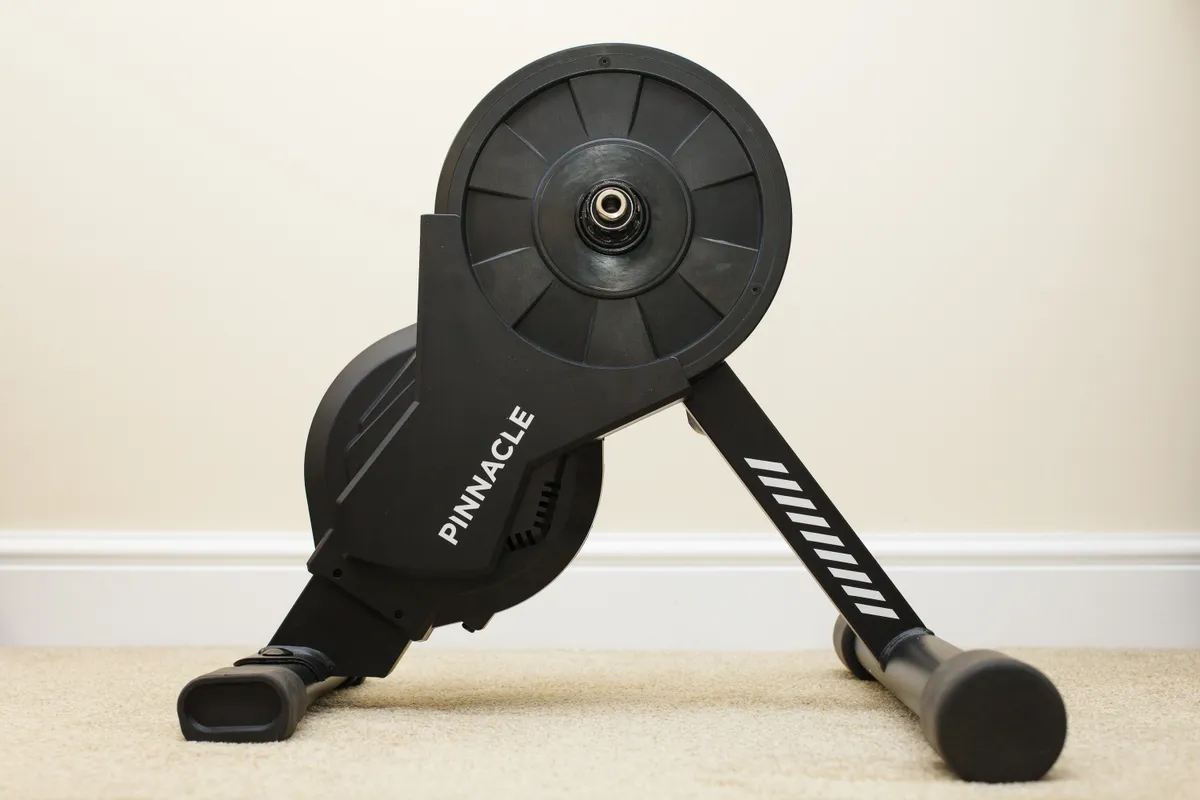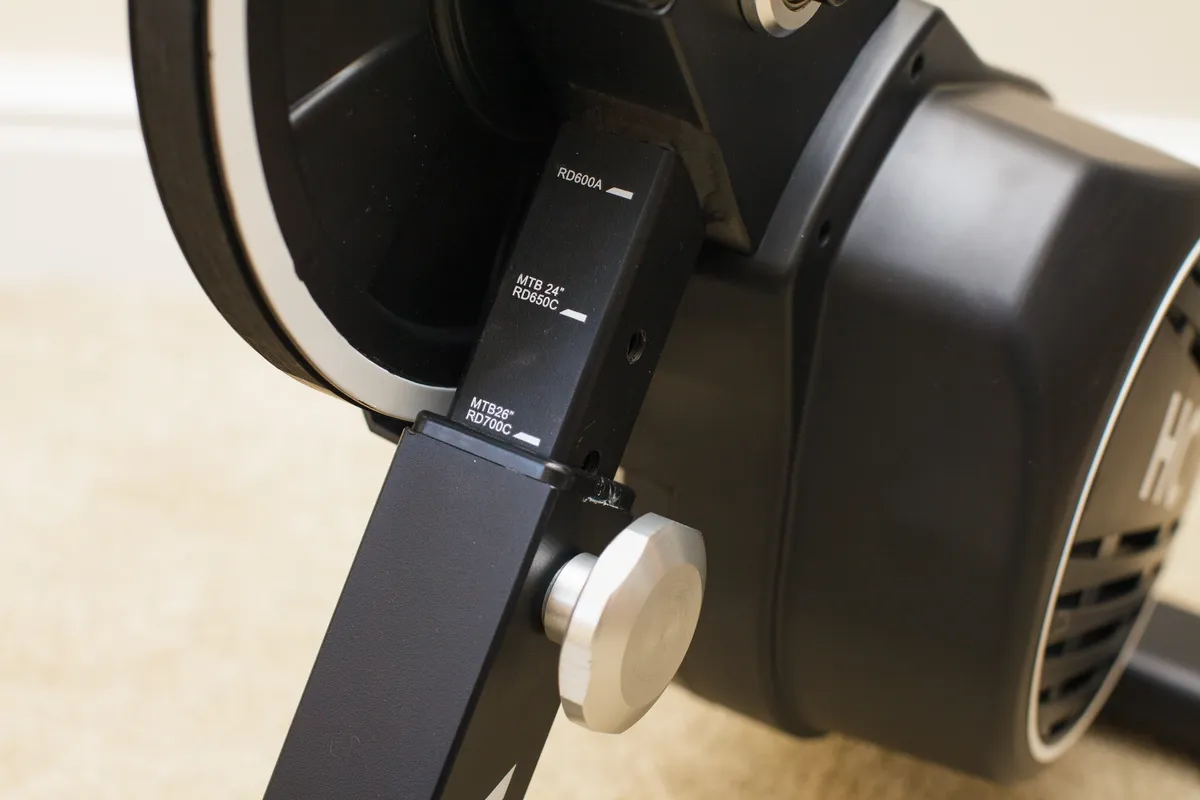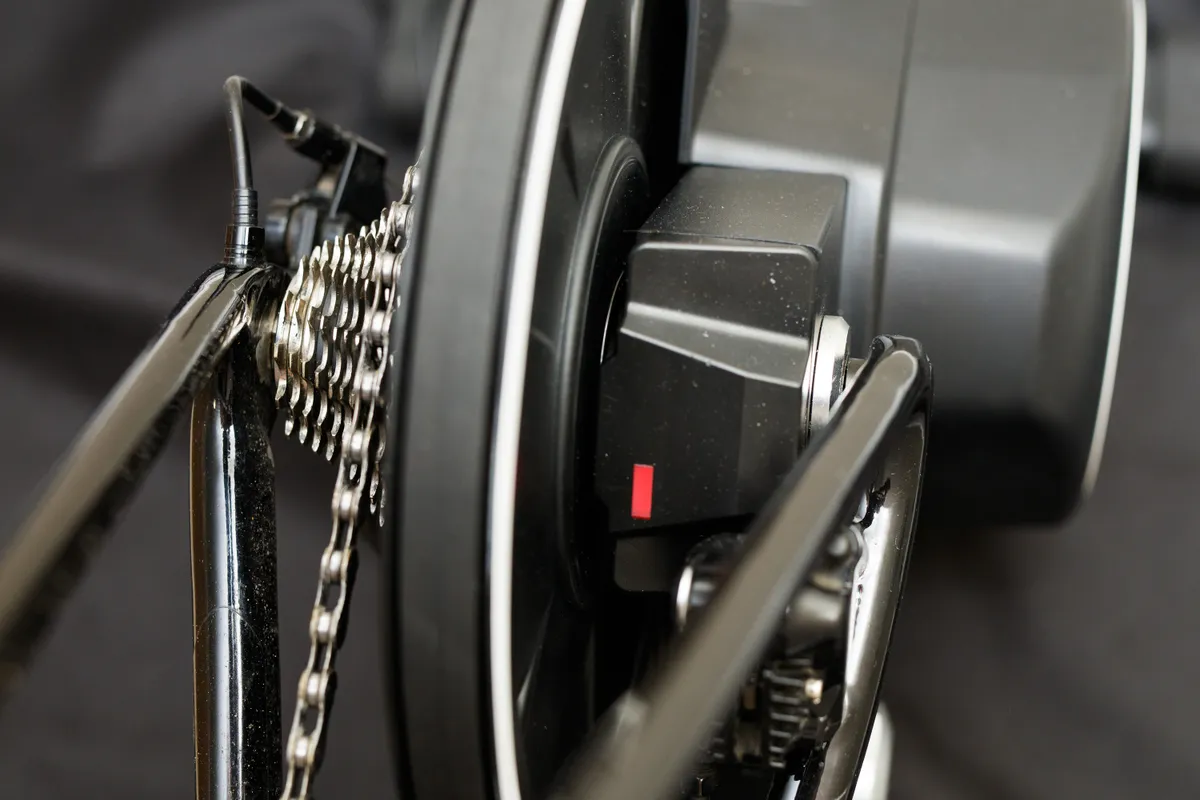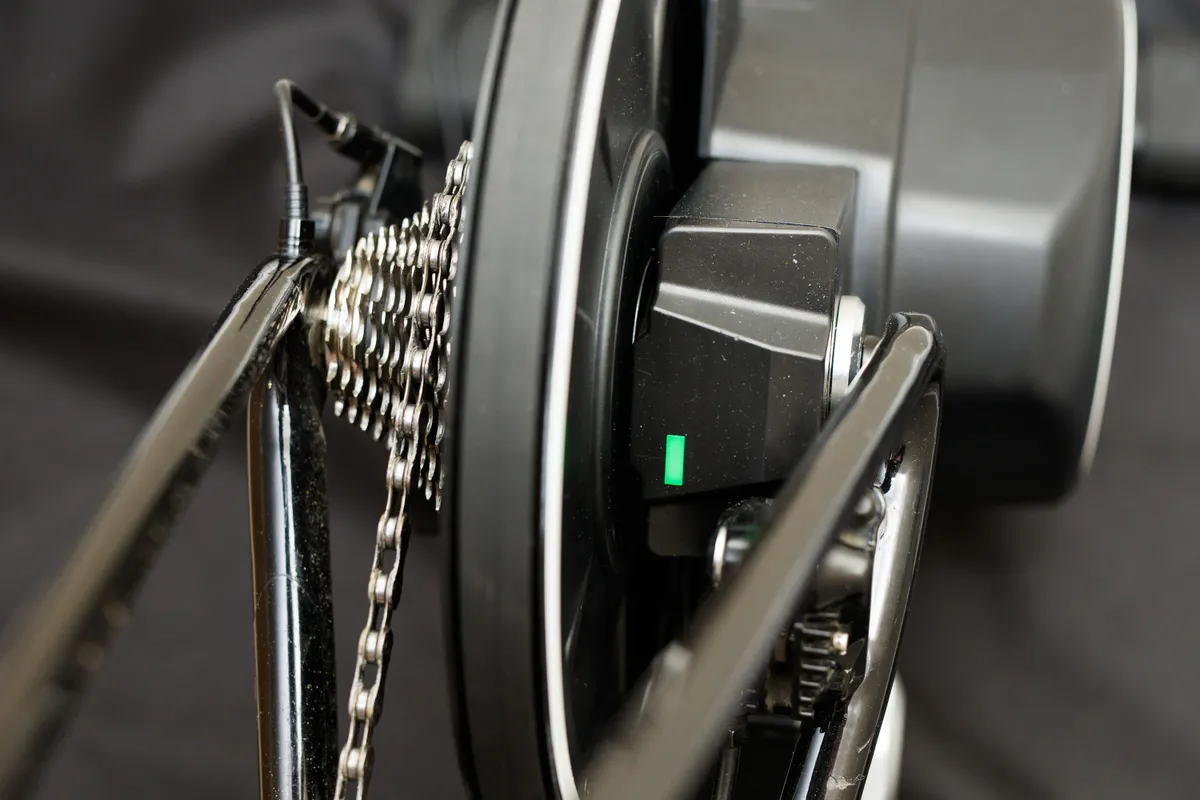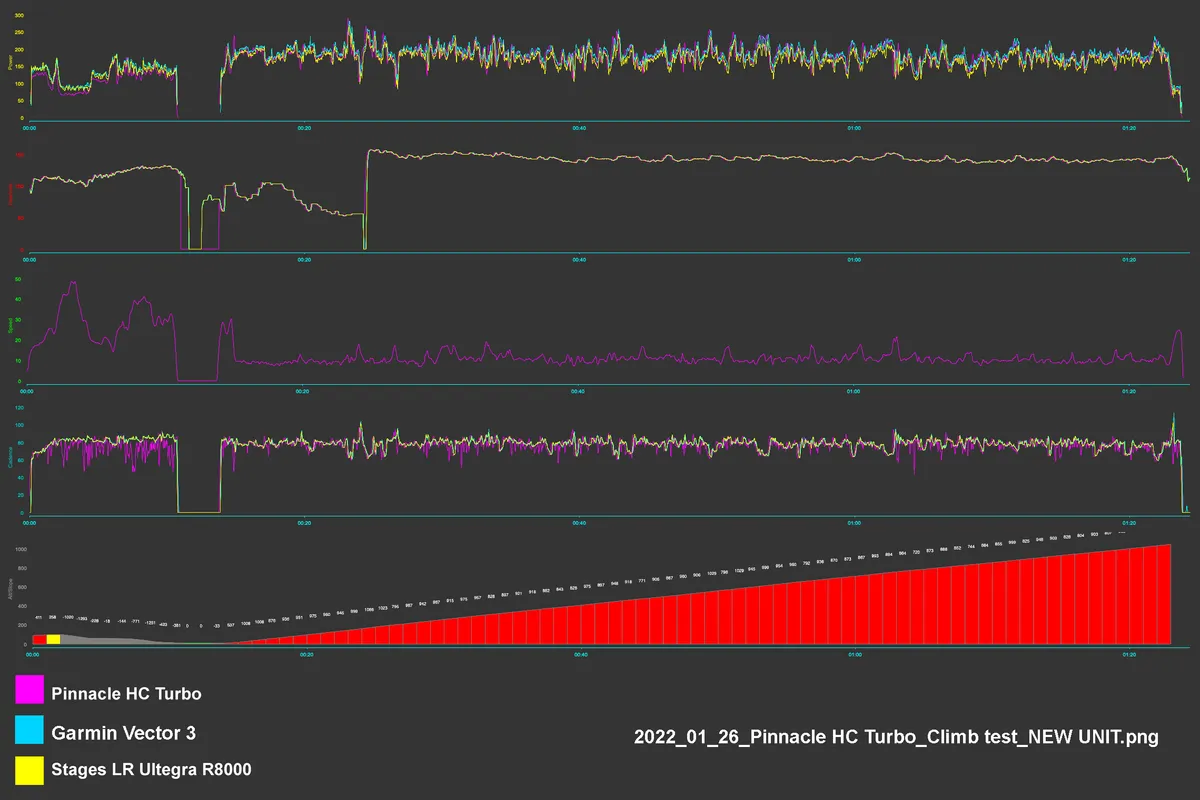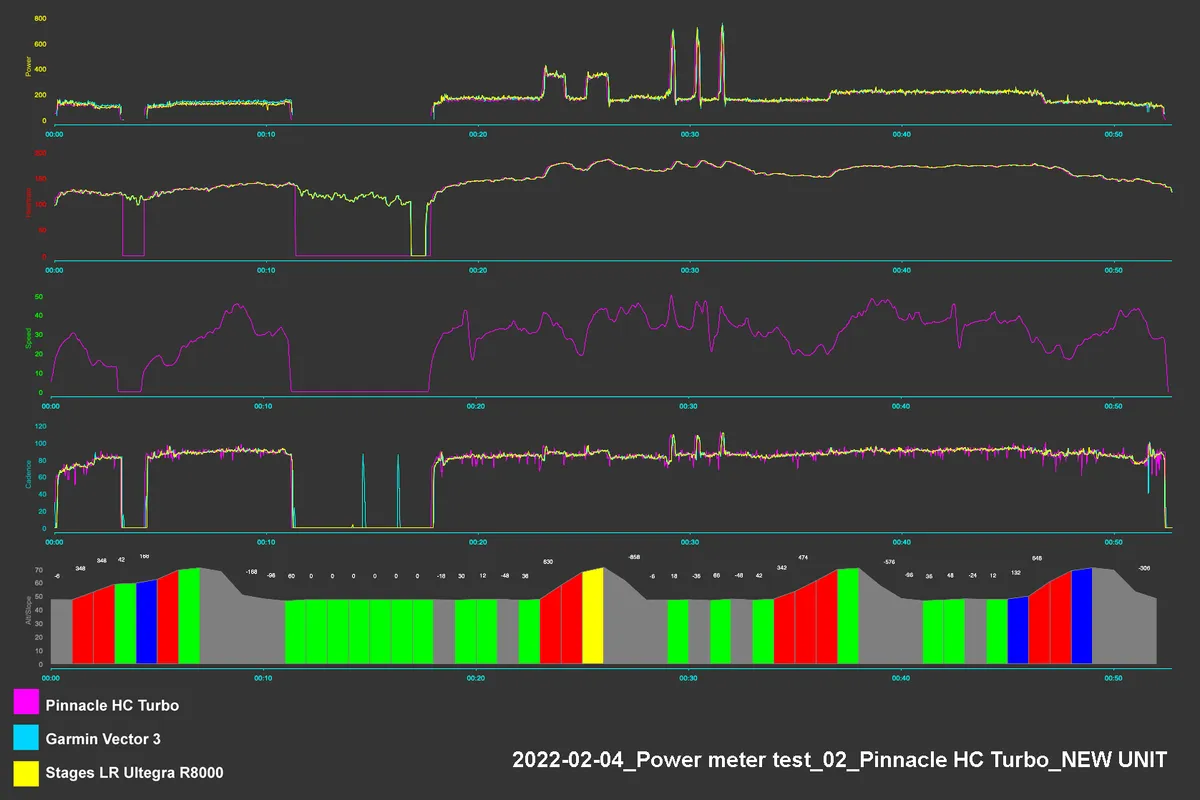The Pinnacle HC Turbo Home Trainer is a direct-drive smart trainer from the in-house brand of Evans Cycles, a UK-based cycling retailer. I tested two units, and though the first one had some clear issues with build quality and data accuracy, the second was much better overall, if still not quite perfect.
Boasting an impressive spec on paper, it was originally launched in November 2021 at an RRP of £700, but has since received a price cut to £499.99.
At the time of writing, the Evans Cycles website says this is a sale or promotional price, but the retailer has confirmed this is a permanent price cut.
The Pinnacle HC Turbo also has a striking visual similarity to the Wahoo Kickr Core, one of the best smart trainers on the market right now.
Pinnacle HC Turbo Home Trainer setup
Setting up the Pinnacle HC Turbo is a pain-free experience. The rear leg simply needs to be bolted on using the included spanner, and the front leg slotted on and set to the desired height to match your bike’s wheel size.
Like the Wahoo Kickr Core, the Pinnacle HC Turbo’s legs don’t fold away for storage. While it’s not the largest smart trainer available, this is something to consider should you lack a dedicated space (a pain cave, for example) to leave it set up.
Fully assembled, it weighs 14.8kg. There’s no integrated carrying handle, but, as with the Kickr Core, its design means it’s still fairly easy to lift and move short distances.
Pinnacle has included axle adaptors for both 130mm / 135mm quick-release and 12x142 / 12x148 thru-axle bikes, so the most common mountain and road bike axle standards should be covered here.

One slightly disconcerting thing is that the freehub body doesn’t sit completely flush to the hub shell, leaving a small amount of the hub internals exposed.
I wondered if the freehub hadn’t been correctly installed, but removing it and reinstalling it left everything the same as before.
While this doesn’t appear to have any immediate impact on performance, I would be concerned about the potential long-term effects of increased dirt, oil and dust ingress – especially if you’re not keeping a fastidiously clean drivetrain.

A SRAM XDR freehub is available separately, but not through Pinnacle/Evans. A Campagnolo-compatible option is not available.
The included freehub is compatible with 8- to 12-speed Shimano HG cassettes. You’ll need to supply your compatible cassette before you can start riding, but a front-wheel riser block is included.
In terms of overall build quality, the Pinnacle HC Turbo lacks the more premium feel of the Kickr Core (which costs £699.99), with its plastic shell looking and feeling a little low-quality.
Whether or not this extends to the internals is obviously impossible to tell without taking it apart, but assuming you’re not bashing it around, this doesn’t affect performance.
Pinnacle HC Turbo Home Trainer performance
Connectivity
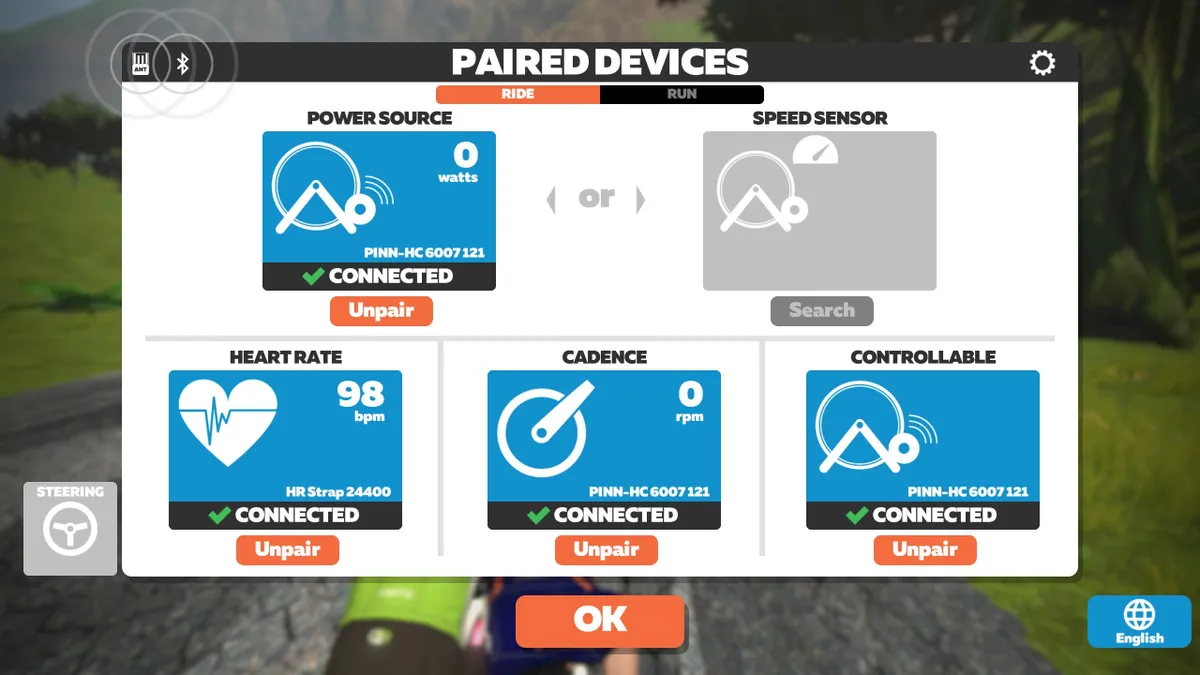
Once plugged in, the Pinnacle HC Turbo was easily found and connected to by Zwift, via Bluetooth and ANT+ FE-C on a MacBook Pro.
Unusually, I wasn’t able to connect it as an ANT+ or Bluetooth power meter to a Garmin Edge bike computer – I could only connect it as a controllable indoor trainer, using ANT+ FE-C.
While this distinction likely won’t bother many people (you can still connect the trainer to a bike computer to ride pre-set courses or workouts, for example), it does scupper any ability to dual-record ride data both on your indoor cycling app of choice and a separate bike computer. This is not something I've encountered with any other smart trainer I’ve tested.
It’s a minor inconvenience, but those who like to record a back-up data file in case their computer/smart device crashes mid-ride are out of luck here.
It also made my job of simultaneously recording multiple power files (for data accuracy comparison purposes) slightly trickier, but there’s no need to break out the small violins on my behalf.
There’s no spin-down calibration option in Zwift, or in the Pinnacle smartphone app. Instead, the trainer performs an automatic calibration after it’s initially switched on.
Given this, it’s important not to use the trainer before the process is complete, as this could lead to it being miscalibrated.
During this process, the light on the top of the trainer will flash red. When finished, the light will flash green, meaning the trainer is ready for use.
The Pinnacle smartphone app (available for iOS and Android) can also be used for updating the trainer’s firmware, and for useful things such as accessing a digital version of the manual and watching setup videos.
Ride feel
With a claimed flywheel weight of 5.7kg (0.3kg heavier than that on the Wahoo Kickr Core), I was expecting the Pinnacle HC Turbo’s ride feel to shine.
I tested two units and unfortunately the opposite was true for the first one.
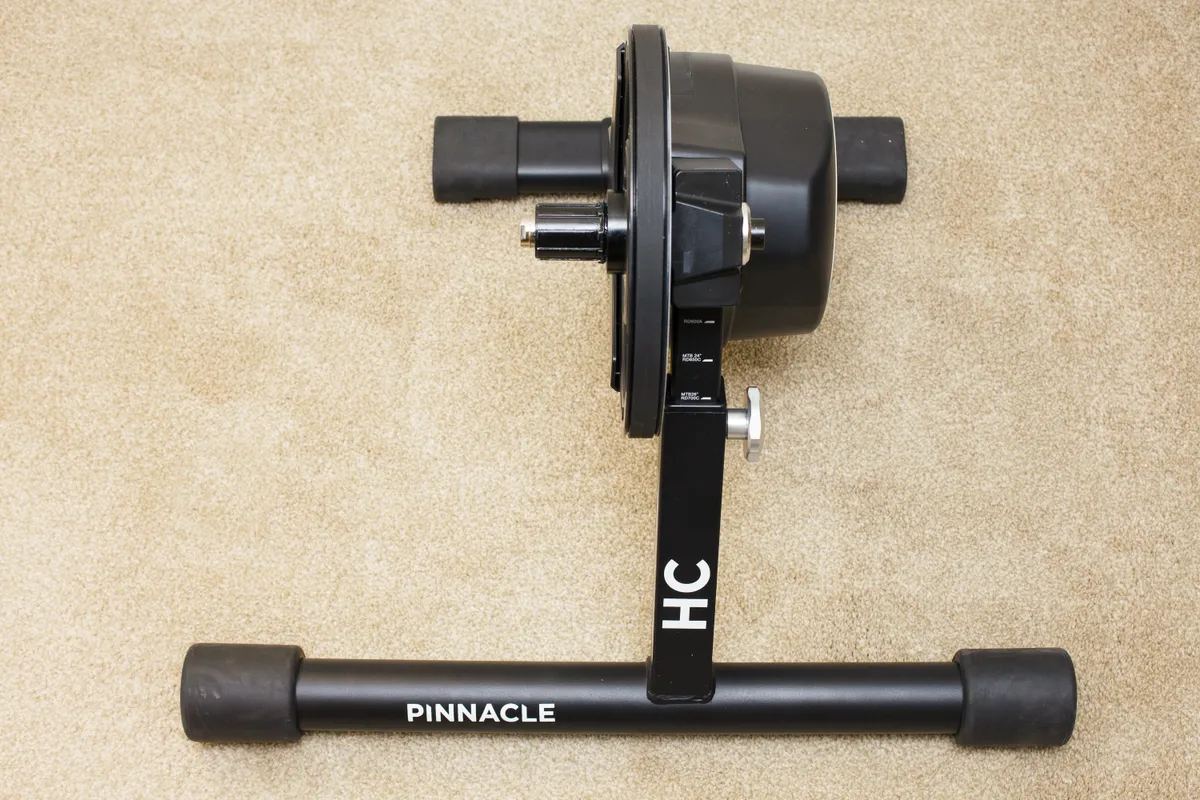
The wide stance of the support legs offers a stable ride and the response to in-game gradient changes was quick on both test units, but the way the flywheel on the first unit delivered inertia felt very choppy.
The flywheel also appeared to be slightly out of true, which led to an annoying rumble at high flywheel speeds.
As I also had issues with power and cadence data accuracy (more on this later), Pinnacle agreed to send a second unit for me to test.
Fortunately, the second unit was much improved, with a far smoother delivery of inertia and no sign of the flywheel rumble.
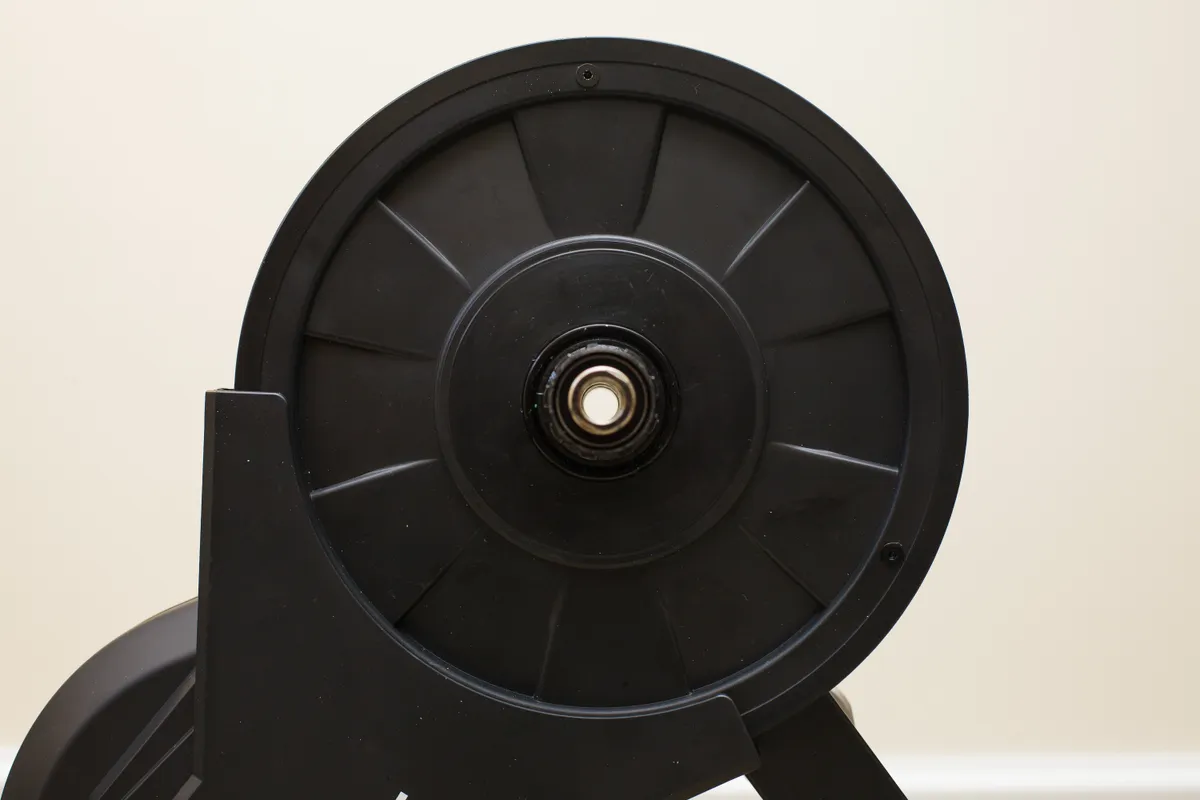
It’s not quite up there with pricier trainers such as the Elite Direto XR or Wahoo Kickr, but there’s little to separate it from closely priced competitors such as the Elite Zumo and Tacx Flux S.
Its 20 per cent maximum gradient and 2,500-watt power ceiling are also the best in its price bracket by a long way, making this a good option for powerful riders on a budget.

Noise
Pinnacle claims the HC Turbo produces 52 decibels (dB) of noise at 19mph / 30.6kph, but in my testing, it was more like 60dB at 30kph.
When I started putting down the power and speeds increased above 25mph / 40.2kph, the HC Turbo’s noise averaged around 65dB.
This was measured on an iPhone placed one metre away from the trainer, parallel to the drivetrain side of my bike.
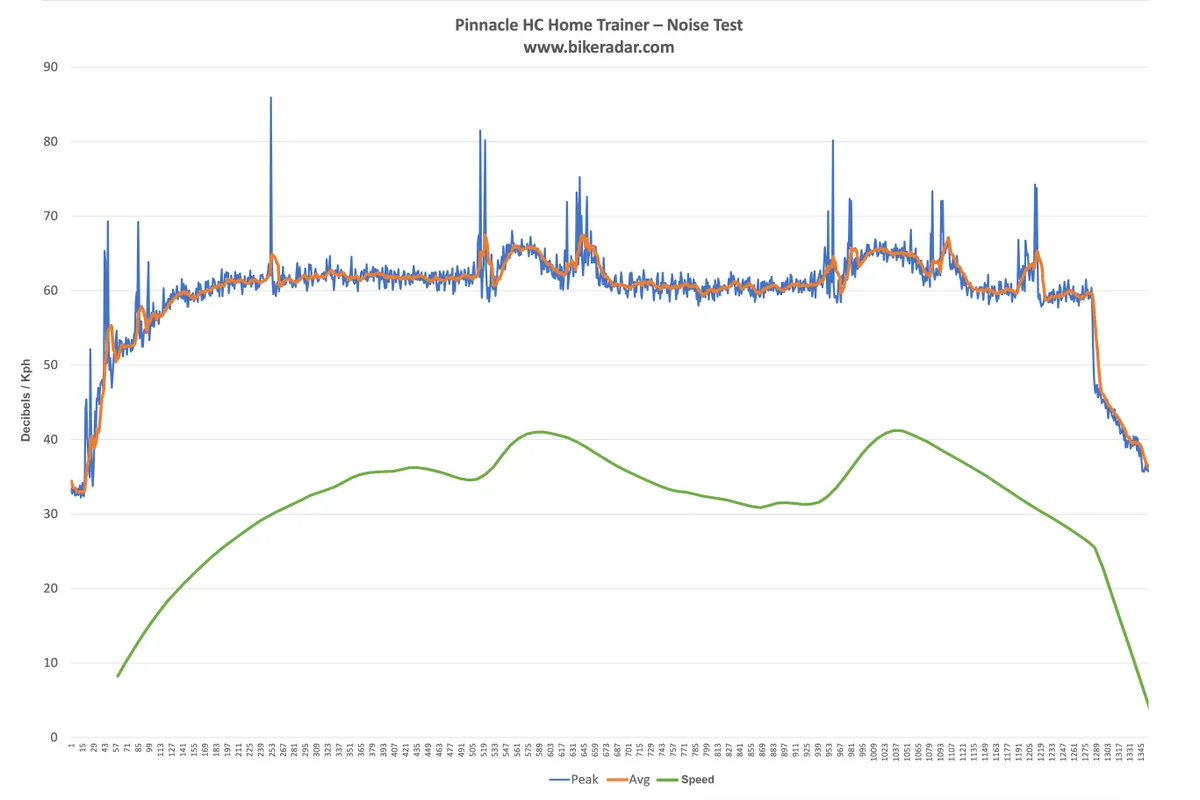
It’s worth noting that this does include the noise coming from my drivetrain, however, so your mileage may vary slightly, depending on what drivetrain and chain lube you’re using (my waxed chains may be efficient, but they’re not always the quietest).
The HC Turbo is pleasingly quiet when riding at a normal pace. The noise levels do ramp up a bit when you’re really going for it, but that’s true of most smart trainers.
Pinnacle HC Turbo Home Trainer power accuracy
Pinnacle claims the HC Turbo is accurate to +/- 2 per cent, though the data from the first unit I tested was very inconsistent, as I alluded to earlier.
With the second unit I tested, though, the data quality was generally much better, bar a few relatively minor niggles
When riding along at an average pace or going uphill at slow speeds, the power and cadence data is mostly very good.
Cadence data is a little spikey compared to some of the best power meters, but is fine on average.
At higher flywheel speeds (around 40kph in-game speed), cadence data accuracy deteriorates significantly, though.
While this can be frustrating, it doesn’t overly affect your in-app experience on Zwift (or similar apps) unless you’re specifically doing rides or workouts with cadence targets at high flywheel speeds.
If you want to do ERG mode workouts with specific cadence targets, I would advise using a low gear in order to keep flywheel speeds relatively low.
It’s also worth noting most other smart trainers at this price point can struggle with cadence data accuracy at times. If it's a key feature for your riding, it could be worth investing in a separate cadence sensor for your bike’s crank arm or a higher-end smart trainer.
I did also notice some occasional drift in the power data, though, which can be more frustrating because power data inaccuracies have a greater effect on your in-app experience.
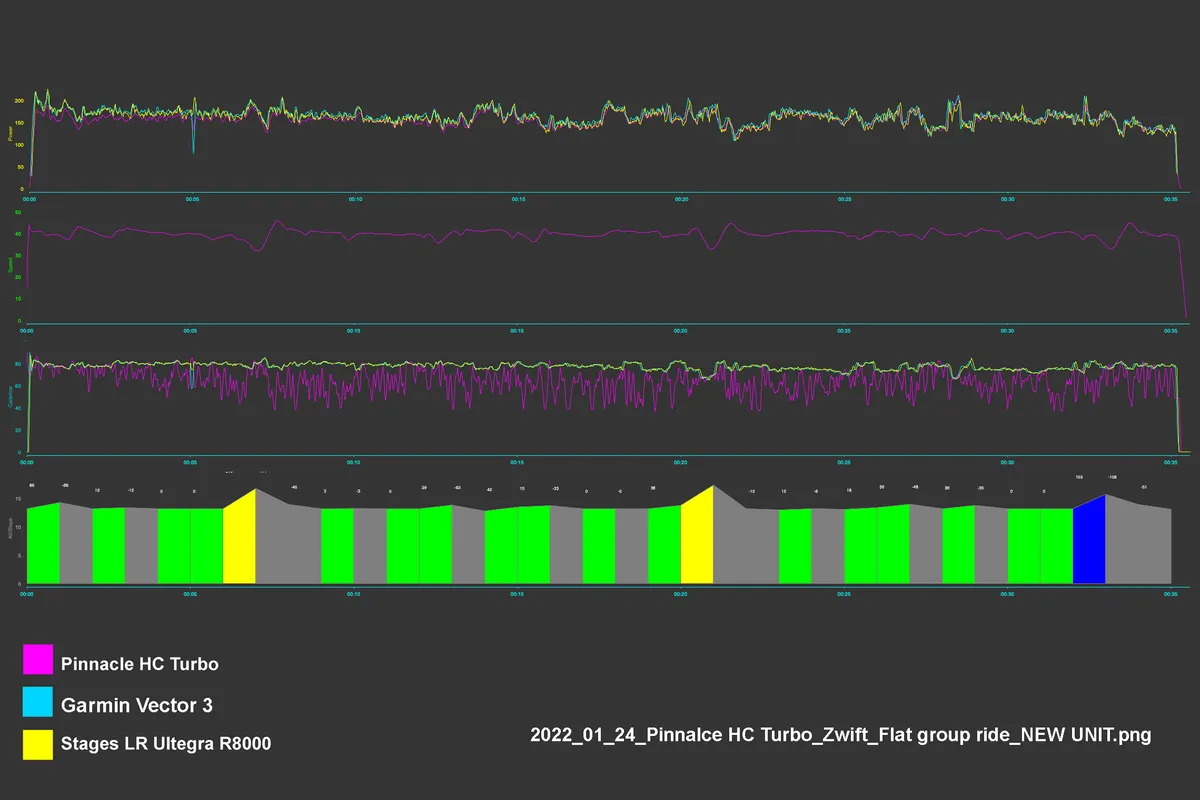
As with the cadence inaccuracies, this often seems to occur during extended periods of high flywheel speeds – which would occur during a Zwift group ride on a flat course, for example.
At other times, it appeared the trainer needed to ‘warm up’, and would start a ride transmitting data on the low side, before coming up to the level of my own-bike power meters after around 10 minutes of riding.
Most of the time, it would then settle and be accurate for the remainder of the ride, though I did see one occasion where the power data continued to drift upwards relative to an on-bike power meter.
The gaps weren’t enormous at any point (around 10 per cent at most), but were enough to be noticeable when trying to hold on to a virtual group ride or doing a targeted workout, as you end up needing to work harder than should be required until the trainer hits the right spot.
In response to my feedback, Pinnacle said it was continuously working on improvements and would look to roll out further refinements via firmware updates in the future.
Pinnacle HC Turbo Home Trainer bottom line
Overall, the Pinnacle HC Turbo Home Trainer does a lot well despite a couple of niggles.
The raw specs are very impressive for a £500 smart trainer and it delivers a strong performance in many areas, such as ride feel, stability and ease of use (providing you’re running the latest firmware and get hold of a unit without any build issues).
If the small power drift issues can be fixed via a future firmware update, that would put the HC Turbo head and shoulders above others in its price bracket. As things stand, though, it’s a slightly more qualified recommendation.
Product
| Brand | Pinnacle |
| Price | £499.99 |
| Weight | 14.80kg |
Features
| Mount | direct_drive |
| Folding legs | no |
| Trainer type | smart_trainer |
| Resistance type | electromagnetic |
| Wheel size | 26in |
| Wheel size | 29in_700c |
| Connectivity | antPlus_fe_c |
| Connectivity | bluetooth_smartphone |
| Device compatibility | android |
| Device compatibility | ios |
| Device compatibility | mac |
| Device compatibility | windows |
| Noise | 60.0000 |
| Noise | DECIBEL |
| Max power | 2500.0000 |
| Max power | WATT |
| Flywheel weight | 5.7000 |
| Flywheel weight | KILOGRAM |
| Max grade (degrees) | 20.0000 |
| Hub compatibility | Shimano HG, 8- to 12-speed |
